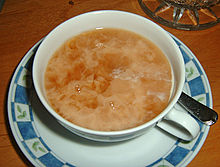Lower Saxon cuisine
The Lower Saxon cuisine consists of a large number of regional, North German cuisines, which are largely similar, such as the Oldenburger , Braunschweiger , or East Frisian cuisine. It is mostly down to earth and partly hearty. The cuisine of the cities of Bremen and Bremerhaven , which are enclaves in Lower Saxony, does not differ significantly from that of the surrounding areas of Lower Saxony.
Soups and stews
Soup is often served before dinner. The wedding soup , a meat broth, is popular here . On the North Sea coast, a plant called is beach trident ( Triglochin maritimum ) under the name "Röhrkohl" known. This grows in the area of the salt marshes directly near the shore and is prepared as a hearty stew like kale. Other rural dishes from the coastal region include turnip stew, as well as pears, beans and bacon , a stew.
Meat dishes
In the Lüneburg Heath and the surrounding area of Bremen as well as in the Schaumburger Land, people like to eat cooked sausage ( Bregenwurst , Kohlwurst , Pinkelwurst ), Knipp (a grützwurst that is also common in the Hanover area), game or wild poultry . An internationally known sausage specialty is the " Braunschweiger ". In addition, in the Gifhorn and Wolfsburg areas, people like to eat Pottwurst with sauerkraut in autumn.
fish
Typical fish dishes are on the one hand near the coast and in the area of the Elbe , Weser , Jade and Ems estuaries , plaice , butt , herring , smelt and mackerel , but trout or eel are often eaten inland . Eel is a specialty around the Steinhuder Meer and Zwischenahner Meer .
Vegetables and side dishes
Most often come potatoes ago as a side dish, which are eaten in different variations, especially as salt or fried potatoes. A popular and typical vegetable in winter is the kale , which is regionally - for example in Bremen and in the Braunschweiger Land - also known as "brown cabbage ". A custom associated with vegetables are the so-called "cabbage tours" in connection with eating kale . Around Burgdorf , Nienburg , Brunswick and Oldenburg Munster country and in the southern part of the Lüneburg Heath and on the Stade Geest is asparagus grown and eaten like.
Desserts and cakes
For coffee you often eat butter cakes , pies or other desserts like the Welfenspeise .
beverages
Lower Saxony is home to many breweries , such as B. in Braunschweig, Jever , Einbeck and Hanover . Three of the oldest beers , some of which have been brewed since the Middle Ages, are the Braunschweiger Mumme , the Goslarer Gose and the Ducksteiner .
The herbal liqueur Jägermeister , which has been produced in Wolfenbüttel , Lower Saxony, since 1935, is the most successful German spirit brand in global competition. In 2012 it was in seventh place in the world ranking of the top 100 premium spirits. 89.2 million 0.7-liter bottles were sold that year, 80% of them in more than 90 countries. The most important sales market is North America with around 31.2 million bottles sold. A center of spirits production is Haselünne in Emsland , where grain has been distilled since the 18th century .
In general, coffee is preferred over tea in Lower Saxony ; In the coastal regions, especially in East Friesland and Friesland, strong tea ( Assam ) with rock candy and cream is drunk. In z. In a somewhat less refined form, tea is also the traditional hot drink in the Emsland region , which is south of East Frisia .
literature
- Peter Ploog (ed.): Lower Saxony cuisine . Komet Verlag, 1st edition 2006, ISBN 978-3898364195 .
- Heinrich Stern: Lower Saxon cuisine. Regional cuisine with tradition . Komet Verlag, 2003, ISBN 978-3898360289 .
Web links
- Regional specialties on Reiseland-Niedersachsen.de
Individual evidence
- ↑ Merkur.de: Jägermeister remains an export hit. Retrieved November 7, 2017 .

